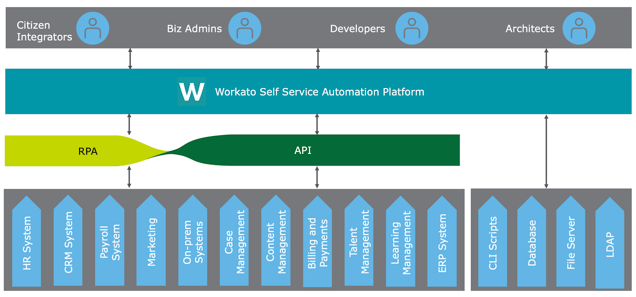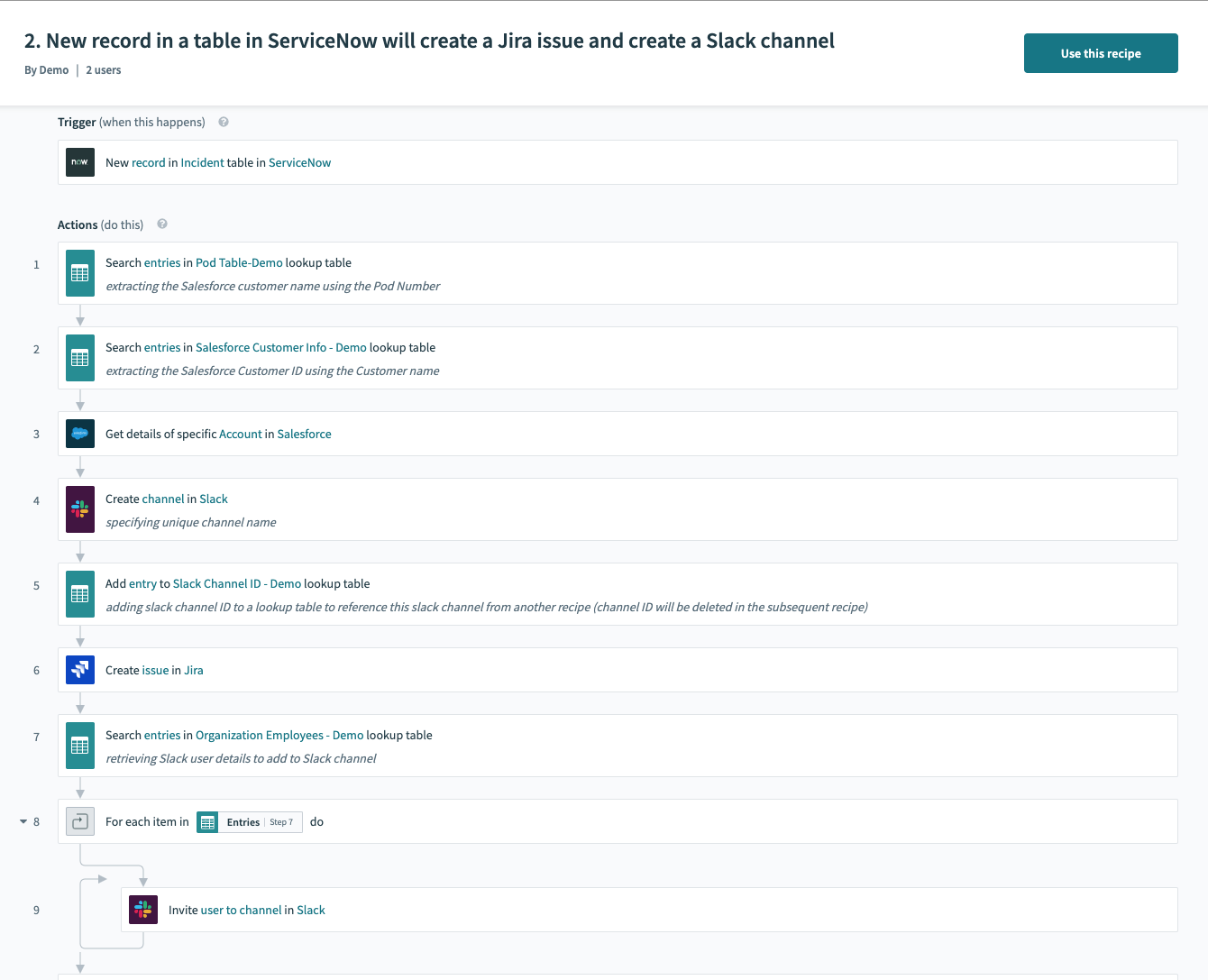In 2019 it is a no-brainer to say that APIs are behind a lot of successful software innovations & SaaS products. In other words, APIs are essentially the enabler of automation and innovation. With the explosion of SaaS products and platforms in recent years, companies are turning to such platforms and their third party APIs as a smarter and faster option for automation success. Some examples include ServiceNow, Salesforce, NetSuite, Workday and Google G Suite.
There are a couple of reasons for this:
- Buy vs Build: It is cheaper, easier and quicker to access on-demand services than to build your own.
- There are well documented and maintained APIs (third party APIs) that are available out of the box (OOTB) for building solutions.
We always hear about many success stories of SaaS. However, in this blog post, I want to talk about some of the side effects associated with the SaaS explosion.
Side effects of the SaaS explosion
As my GP often says, there are no drugs without any side effects. This also holds true for SaaS. In this section, let's look at some of the side effects of the SaaS explosion and our current state of work.
- Users are required to log into many SaaS applications to do their day to day work. E.g. timesheet systems, forecast systems, leave application systems and payroll systems.
- Dependency on developers with specialised skill sets to build that last mile integration for end-to-end automation, which connects multiple SaaS systems.
- Automation initiatives are stuck in the IT queue. Many of the internal initiatives to boost employee productivity often get ignored, which leads to employee dissatisfaction.
- The SaaS integration landscape is actually becoming more complex. Collaboration between IT and business teams who understand the real business needs & data requirements are becoming increasingly harder.
- Business teams are forced to embed integration logic within various SaaS products via plugins and custom code, which is often very inflexible. Anything impossible within the SaaS platform gets pushed out to the integration IT team causing the build-up of spaghetti architecture. This leads to maintaining expensive resources on both the integration and SaaS sides to maintain the integration spaghetti.
Whilst there are indeed some problems, they are problems worth solving as SaaS is here to stay and will only grow bigger. At Deloitte Platform Engineering we believe that one of the solutions to the above problems is self-service automation. Workato is a new self-service automation tool in our automation arsenal. In this blog post, let’s first get an overview of Workato. Later in this post, we’ll look into how a platform like Workato can start solving some of these problems and the future state of work.
Workato Overview
Workato is an IFTTT like automation platform which can be used by Citizen Integrators to develop integrations in English as opposed to code. Workato was ranked highly by Forrester, and Gartner in their latest reports. The biggest value proposition of the platform is the accelerated time to value as it takes only a few days to make your integrations production-ready. A sample integration involving Salesforce, JIRA and Slack is shown below.
For further reading, please refer to the Workato Community Recipes for a huge collection of examples, which can then be used as a starting point for your integration use case.
Strengths of Workato
Let’s now look at some of the high-level strengths of Workato.
- Easy to use, intuitive and low code platform where most of the development is done by drag and drop.
- Shallow learning curve.
- Button click testing feature allowing the integration to be tested repeatedly during development.
- Automatic version control for every change in the integration.
- Flexible data retention policies and log replication capabilities.
- Ability to mask data and keep sensitive data hidden from others on the system.
- Chat integration with popular platforms like Slack, Microsoft Teams and Facebook Workplace.
- True iPaaS without having to worry about CPU, Cores, etc. Pricing is primarily based on the number of integrations/recipes.
- Strong connector ecosystem with many 100s of connectors.
- Incorporating your own internal APIs is a piece of cake. A great value proposition allowing enterprises to roll out their enterprise APIs as connectors for business teams to consume.
- Develop in collaboration with developers, SaaS admins and Business Analysts.
- Dashboard, role-based access, audit and API platform.
- Companion connectors to assist with ETL processes.
- Hybrid integration options supporting cloud-to-cloud, on-prem-to-cloud integrations.
- OOTB support for various patterns such as real-time, batch/bulk, chat integration, state management, etc.
- OOTB support for various integration features. E.g. pub/sub topics, common data model, reusable child recipes, lookup tables, secure connections, stateful processes, error retries, message templates, API platform and webhooks.
Workato Sweet Spot

As shown in the above diagram, the sweet spot of Workato lies around self-service automation use cases like:
- Completing the critical last mile of integration connecting the APIs of a few SaaS systems together to make automation.
- Making the data and notifications of SaaS/RPA/BPM systems available in a collaboration tool, such as Slack, for best in class employee experience.
- Connecting RPA (manual task automation) and APIs together to create an end-end business process.
- Piecing the workflows in two systems together. E.g. connecting onboarding workflow in Workday and ServiceNow to form an end-end onboarding experience.
- Building a chatbot connecting the APIs and on-prem systems.
Solving the side effects of SaaS explosion with Workato
We looked at the Workato platform and its strengths, especially around integrating SaaS systems. As I mentioned earlier, there are some side effects associated with the SaaS explosion. Let’s now look at how Workato can solve some of the side effects we discussed above.
- Providing users with a single pane of glass view of their day to day work.
Chat integration is one of the most powerful features of Workato. Enterprise chat platforms such as Slack, Microsoft Teams and Facebook Workplace are getting increasingly popular these days. These platforms are playing a big part in improving business productivity through team communication and collaboration.
- Reducing the developer dependency to build the last mile integration connecting multiple SaaS systems.
Modern SaaS systems are very sophisticated with features like APIs and webhooks. However, connecting SaaS systems together the traditional way using developer only tools is slowing down many automation initiatives. The shallow learning curve, simplicity, and intuitiveness of the platform makes Workato an ideal platform for users like Biz Admins and Citizen Integrators.
- Accelerating automation initiatives (internal ones) to boost employee productivity.
Speed to market and low cost is the key for internal automation initiatives to get approved. Workato’s connector ecosystem and shallow learning curve make it a platform with great “time to value” value proposition. Here is a great example, which Slack did recently to improve employee productivity. Workato is a great platform for building such initiatives very quickly.
- Providing the right tools to business teams which they can understand and collaborate.
Educating business users and admins on REST is much easier than teaching them SOAP. However, it is still not good enough! You need a different approach to automation that would appeal to people who never imagined themselves as programmers. The Workato platform is an attempt in this direction, which we believe could play a big part in employee up-skilling towards automation.
- Eliminating the build-up of integration spaghetti in SaaS and Integration platforms.
Ideally, you want the SaaS products and associated integrations to be looked after by business teams. Having a business admin friendly integration platform makes it easy to maintain all integrations in a central place. Once implemented, the SaaS admins should be able to maintain and make modifications to integrations to support growing business needs.
Wrap up
Trying to solve all your automation problems with one single platform such as an RPA, BPM or an API platform is not a good idea. Workato is at its best when used as a complementary platform to existing platforms such as API and RPA platforms, as shown in the above diagram. Our expertise in the integration and automation space can help identify the Workato sweet spots & make the best design choices. Check out the official Workato blogs for a variety of customer success stories and use cases.


